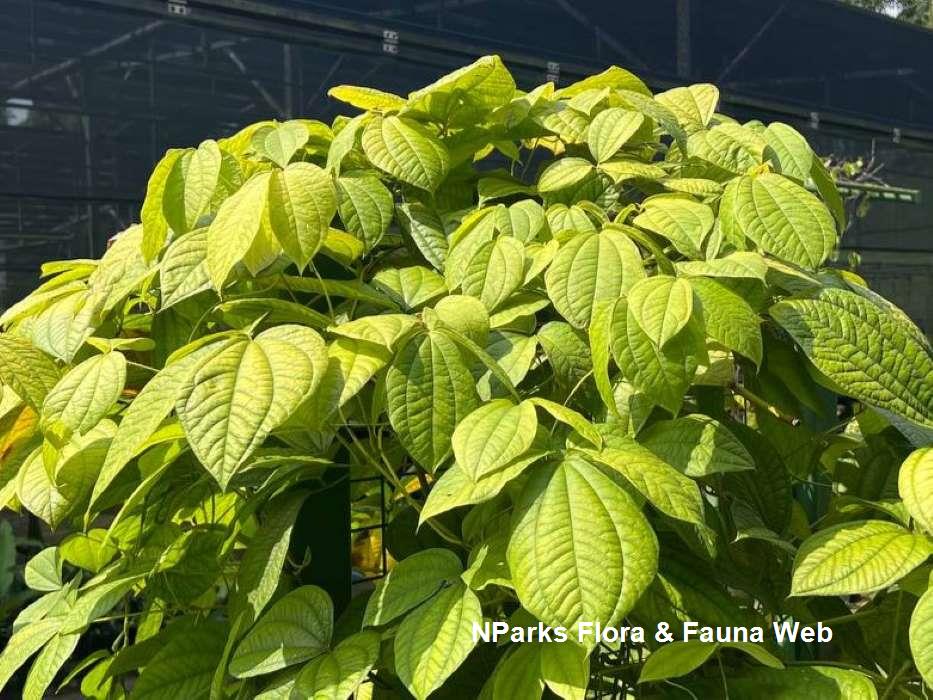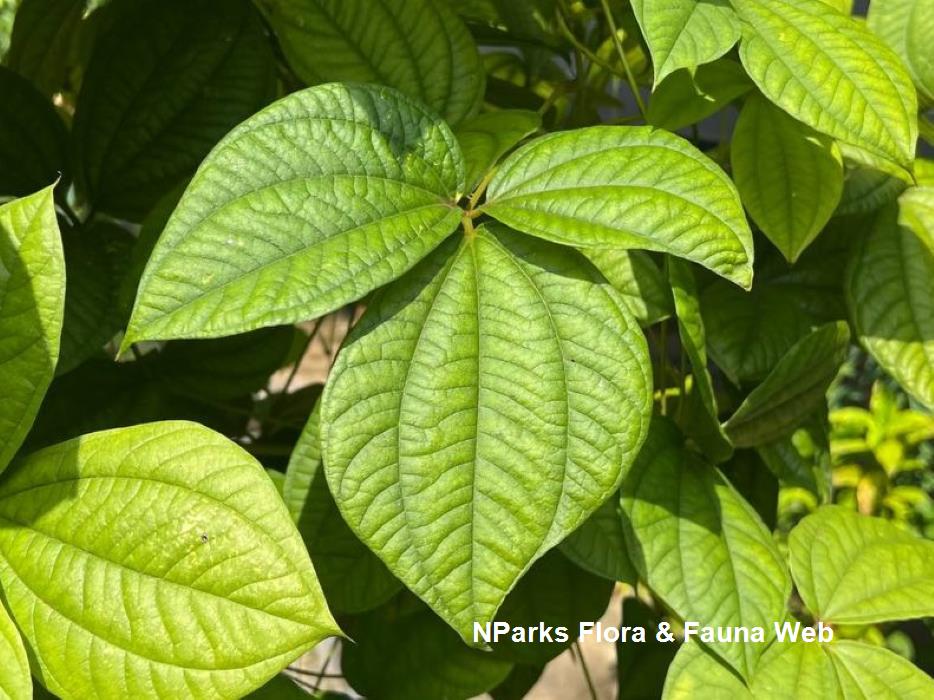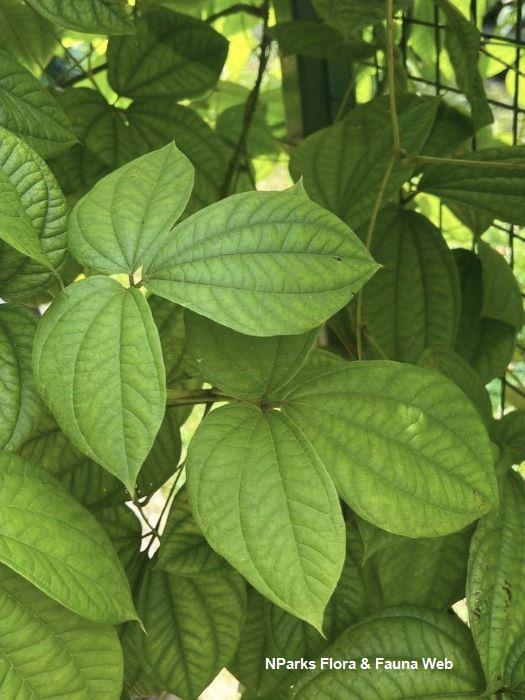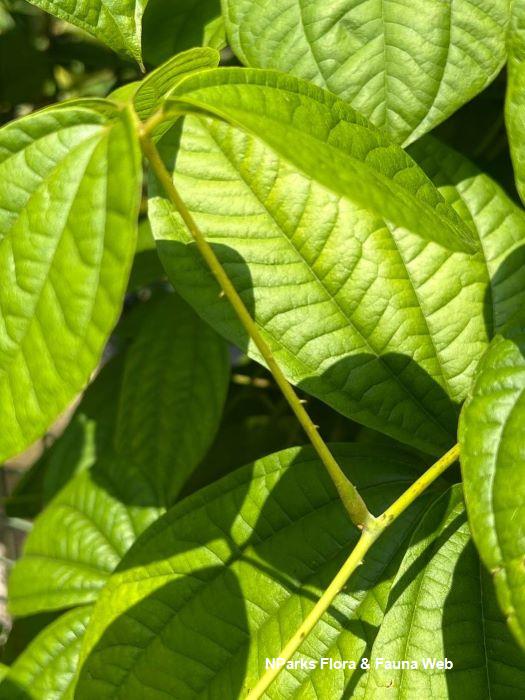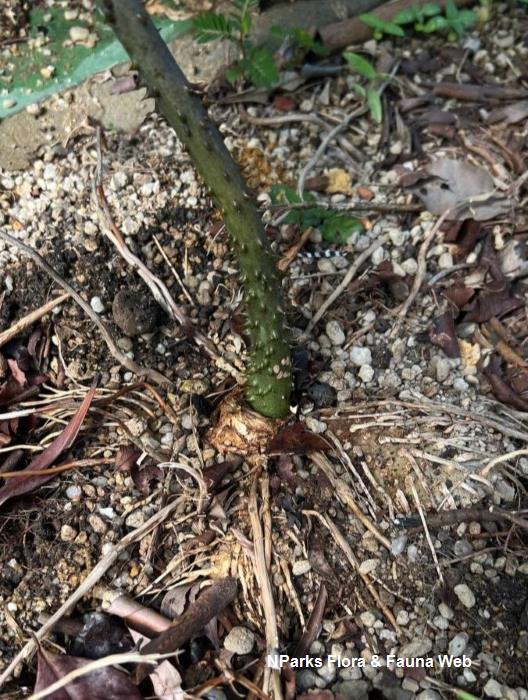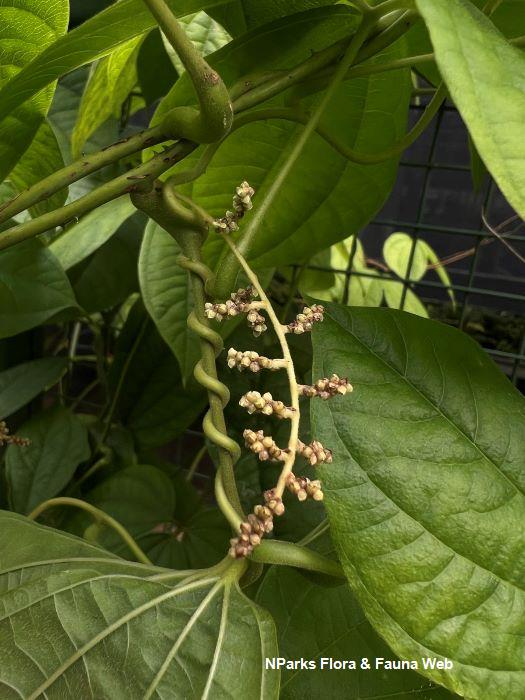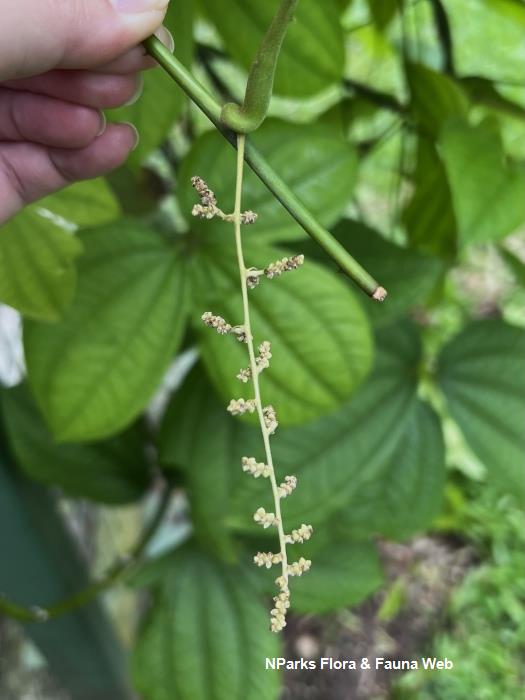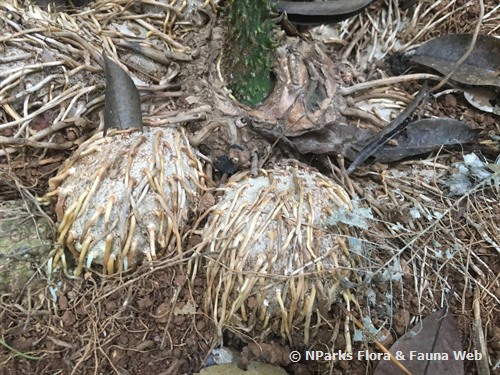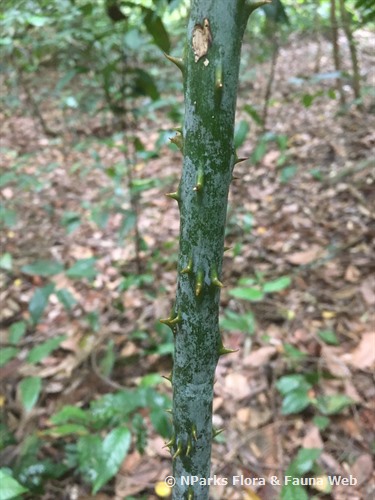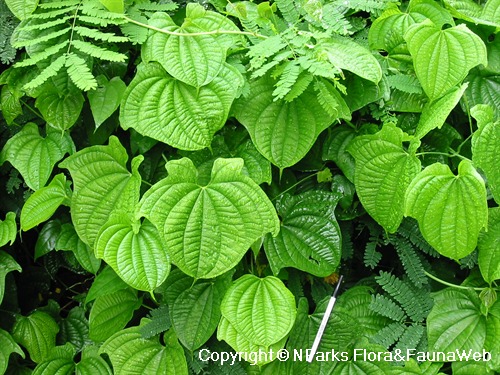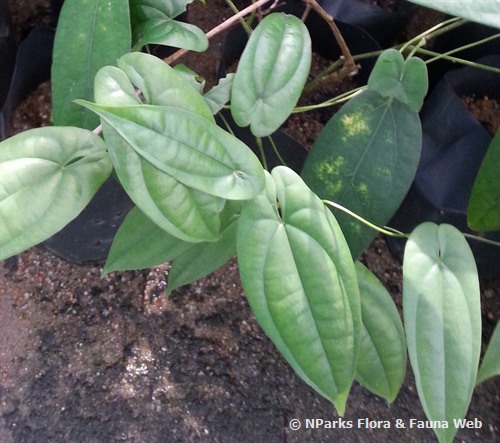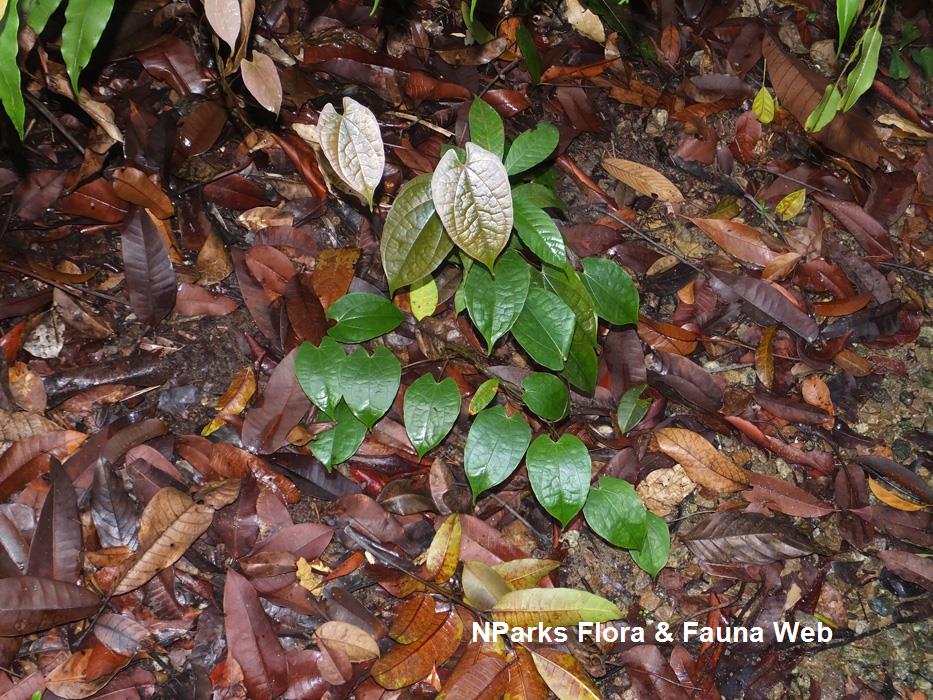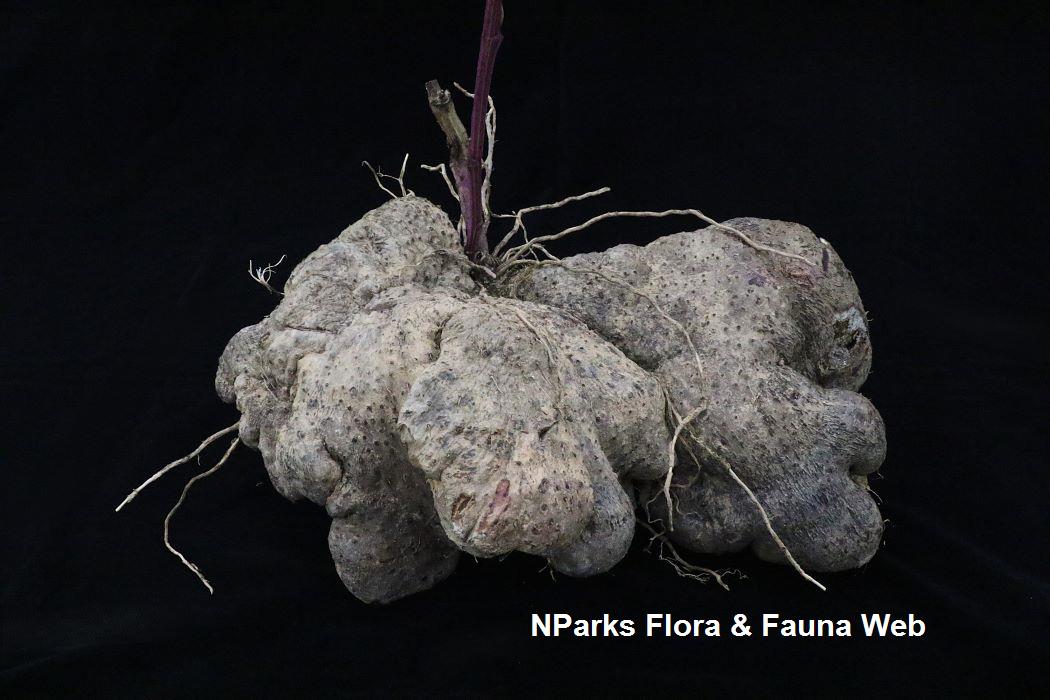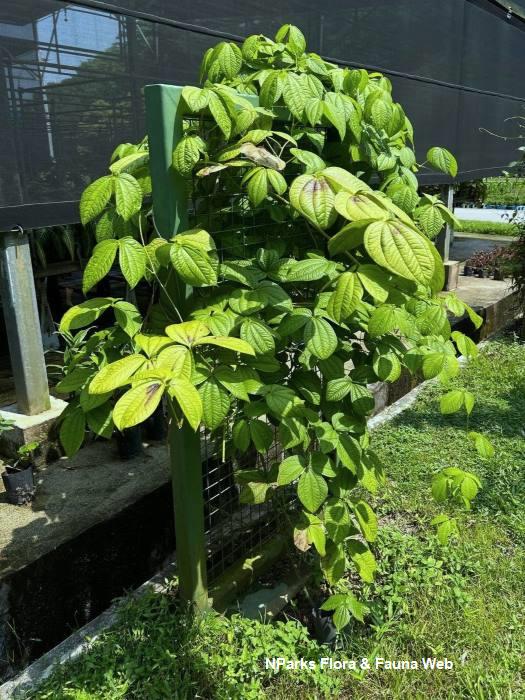
Back
Dioscorea hispida Dennst.
| Family Name: | Dioscoreaceae |
| Synonyms: | Dioscorea daemona Roxb., Dioscorea daemona var. reticulata Hook.f., Dioscorea hirsuta Blume, Dioscorea lunata B.Heyne ex Roth, Dioscorea mollissima Blume, Helmia daemona (Roxb.) Kunth, Helmia hirsuta (Blume) Kunth, Dioscorea hispida var. daemona (Roxb.) Prain & Burkill, Dioscorea hispida var. mollissima (Blume) Prain & Burkill, Dioscorea hispida var. scaphoides Prain & Burkill, Dioscorea triphylla var. daemona (Roxb.) Prain & Burkill, Dioscorea triphylla var. mollissima (Blume) Prain & Burkill |
| Common Name: | Intoxicating Yam, Indian Three-leaved Yam, Gadong, Gadung, Gadu, Gadog, Kaui, Khoei, Sikapa, Sikapang, Boti, Kasimun, 白薯莨 |
Dioscorea hispida, commonly known as Intoxicating Yam, is a native climber that produces compound leaves with three leaflets, and pendulous inflorescences that occur either individually or as a compound spike, depending on the sex of the flowers. The stems and leaf stalks are covered in prickles. It also produces underground tubers that are toxic when not prepared correctly.
Name
Classifications and Characteristics
| Plant Division | Angiosperms (Flowering Seed Plants) (Monocotyledon) |
|---|---|
| Plant Growth Form | Climber |
| Lifespan (in Singapore) | Perennial |
| Mode of Nutrition | Autotrophic |
Biogeography
| Native Distribution | Andaman Islands, India, Bangladesh, Tibet, Nepal, West Himalaya, East Himalaya, Southeastern China, Hainan, Taiwan, Myanmar, Laos, Cambodia, Vietnam, Thailand, Malaysia, Singapore, Borneo, Philippines, Sumatra, Java, Lesser Sunda Islands, Moluccas Islands, New Guinea, Bismarck Archipelago |
|---|---|
| Native Habitat | Terrestrial (Monsoon Forest) |
| Preferred Climate Zone | Tropical, Sub-Tropical / Monsoonal |
| Local Conservation Status | Native to Singapore (Critically Endangered (CR)) |
Description and Ethnobotany
| Growth Form | It is a robust, perennial, herbaceous climber that can reach 20 m in height. It has a twining growth habit. |
|---|---|
| Foliage | The alternately arranged leaves are compoundly trifoliate (with three leaflets) and covered in stiff bristles and chartaceous (feeling like paper). The middle leaflet is egg-shaped to elliptic, measuring up to 6 - 12 cm long × 4 - 2 cm wide while the lateral leaflets are ovate-elliptic or nearly broadly oblong, oblique, and generally smaller than the middle leaflet. The petiole (leaf stalk) is up to 25 cm long and covered in prickles. The sunken venation is prominent on the leaflets and arranged in a net-like pattern. |
| Stems | The stems are pubescent when young, lightly covered in prickles, and occasionally glaucous (covered with a waxy, bluish grey layer). The stem base is densely covered in prickles. The stems climb by twining anti-clockwise up tree trunks or vertical supports. |
| Flowers | The inflorescence is a pendulous spike, occurring as a panicle of spikes per node for male inflorescences (up to 50 cm in length) or individually per node for female inflorescences (up to 40 m in length). Male inflorescences are usually produced before the leaves fully develop, while female inflorescences do not appear until the leaves are fully developed. Each inflorescence may hold up to 40 flowers. The flower is imperfect, having six small tepals (petals and tepals that are indistinguishable from one another) with floral bracts, and either male or female reproductive organs. |
| Fruit | The fruit is an elongated capsule (a type of dehiscent dry fruit), up to 3.5 - 7 cm long, with three lobes. Each fruit contains about three winged seeds, one per lobe. |
| Reproductive Parts - non-flowering plant | It produces underground tubers that grow near the surface. The tubers are generally globose, egg-shaped or irregularly shaped with elongated lobes. The tubers are variable in size, 9 - 25 cm long × 6 - 20 cm wide and up to 35 kg,. They are brown or straw-coloured to light grey, with a white to lemon-yellow poisonous flesh. Bulbils are absent in this species. |
| Habitat | It can be found in scrub forests and forest margins, at elevations ranging from 0 to 1500 m above sea level. |
| Cultivation | It can be propagated by seeds and tubers. |
| Etymology | The generic epithet Dioscorea is named after Dioscorides Pedanios of Anazarbeus, a 1st Century Greek physician and herbalist who was the author of 'Materia Medica'. The specific epithet hispida is Latin for "bristly," or "hairy", referring to the plant's prickles and hairy leaves. |
| Ethnobotanical Uses | Edible Plant Parts : Edible Storage Organs Medicinal: In Indonesia and China, the grated tuber is applied to treat leprosy, skin diseases, corns, calluses, and whitlow (a viral infection of the toe or nail cuticle) of the feet. It is also applied to syphilitic sores, together with the tuber of Smilax china L. In Thailand, sliced tubers are applied topically to relieve abdominal spasms and colic, as well as to remove pus from wounds. In the Philippines and China, the tuber is used to treat arthritis and rheumatism, as well as to clean maggot-infested wounds in animals. <2> Cultural / Religious: In India, a meal made from the processed tuber is eaten for fast days. Others: The tubers are eaten as famine crops by locals in their native region. The flesh must be peeled, sliced, or chopped, and soaked in several changes of water or salt water, or in running water to remove the toxic alkaloid. <1> In Thailand, the tubers are a popular food despite being poisonous, where they are boiled or steamed after preparation and mixed with other foods such as sticky rice, sugar, and coconut milk or fried with sliced banana and rice flour. <3> |
Landscaping Features
| Desirable Plant Features | Ornamental Foliage |
|---|---|
| Landscape Uses | Trellis / Arbour / Pergola |
| Thematic Landscaping | Economic Garden |
| Usage Hazard - Cons | Spines/Thorns - Stem/Branch, Toxic Upon Ingestion |
| Usage Hazard - Cons Remarks | Spines/Thorns Stem branches: The stems are covered in prickles, which may injure passers-by. Toxic Upon Ingestion: All plant parts contain neurotoxic alkaloids, dioscorine and dioscoricine, which can cause throat discomfort, giddiness, nausea, vomiting and sleepiness when consumed. Keep plants out of reach of children and pets. |
Fauna, Pollination and Dispersal
| Pollination Method(s) | Biotic (Fauna) (Insects (Ant, Beetle, Fly, Thrip, Wasp)) |
|---|
Plant Care and Propagation
| Light Preference | Full Sun, Semi-Shade |
|---|---|
| Water Preference | Moderate Water |
| Plant Growth Rate | Fast |
| Rootzone Tolerance | Fertile Loamy Soils, Well-Drained Soils |
| Propagation Method | Storage Organ (Stem Tuber), Seed |
Foliar
| Foliage Retention | Evergreen |
|---|---|
| Mature Foliage Colour(s) | Green |
| Mature Foliage Texture(s) | Spiny / Bristly / Stinging |
| Foliar Type | Compound (Trifoliate) |
| Foliar Arrangement Along Stem | Alternate |
| Foliar Attachment to Stem | Petiolate |
| Foliar Venation | Pinnate / Net, Reticulate |
| Foliar Margin | Entire |
| Foliar Apex - Tip | Acuminate |
Non - Foliar and Storage
| Stem Type & Modification | Climbing Tendril, Thorn / Prickle |
|---|---|
| Root Type | Underground (Fibrous Root) |
| Specialised Storage Organ(s) | Underground (Stem Tuber) |
Floral (Angiosperm)
| Flower & Plant Sexuality | Unisexual Flowers , Monoecious |
| Flower Colour(s) | Brown |
|---|
| Flower Texture(s) | Velvety / Furry / Tomentose |
| Flower Grouping | Cluster / Inflorescence |
| Flower Location | Axillary |
| Inflorescence Type | Panicle, Spike |
| Ovary Position | Inferior / Epipgynous |
| Flowering Habit | Polycarpic |
Fruit, Seed and Spore
| Mature Fruit Colour(s) | Brown |
|---|---|
| Mature Fruit Texture(s) | Velvety / Furry / Tomentose |
| Fruit Classification | Simple Fruit |
| Fruit Type | |
| Mature Seed Colour(s) | Brown |
| Seed Description | Ovoid-lenticular, up to 6 - 13 m long × 6 - 10 mm wide, with oblong to ovate-oblong wings extending from seed base, up to 14 - 25 cm long × 8 - 12 mm wide |
| Seed Quantity Per Fruit | Few (1-5) |
References
| References | <1> Burkill, I.H. (1951). Dioscoreaceae. In: Van Steenis, C.G.G.J. (ed) Flora Malesiana, Ser. 1, Seed Plants, Vol. 4: 293–335. Leiden: Noordhoff. <2> Chung, R.C.K. (2001). Dioscorea L. In: van Valkenburg, J.L.C.H. and Bunyapraphatsara, N. (Editors): Plant Resources of South-East Asia No 12(2): Medicinal and poisonous plants 2. PROSEA Foundation, Bogor, Indonesia. <3> 19. Dioscorea hispida Dennst. e-Flora of Thailand. https://botany.dnp.go.th/eflora/floraspecies.html?tdcode=04128 (Accessed 25 September 2025) <4> 38. Dioscorea hispida Dennst. Flora of China. http://www.efloras.org/florataxon.aspx?flora_id=2&taxon_id=200028114 (Accessed 25 September 2025) |
|---|
Image Repository
Others
| Master ID | 33709 |
|---|---|
| Species ID | 8123 |
| Flora Disclaimer | The information in this website has been compiled from reliable sources, such as reference works on medicinal plants. It is not a substitute for medical advice or treatment and NParks does not purport to provide any medical advice. Readers should always consult his/her physician before using or consuming a plant for medicinal purposes. |

